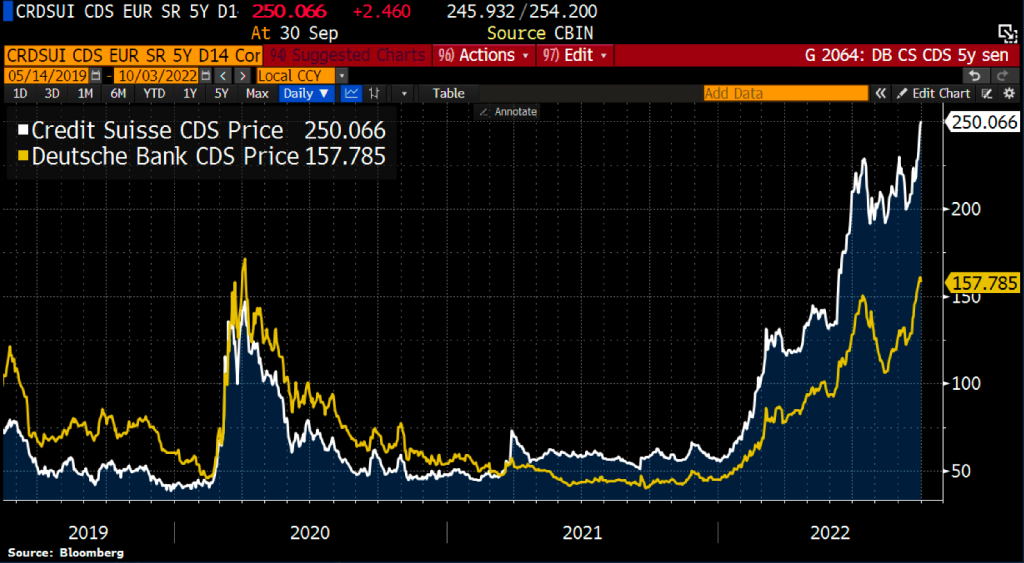
Last week in review:
Last week was a fairly tumultuous week in terms of headline driven news. Sunday evening brought the onslaught of the Pound Sterling, crashing -4.5% to 1.0392 vs the USD – its lowest level since 1985. The “crash” was driven largely from the announcement late last week of the expected tax cuts and plans for additional spending in the UK. Tuesday/Wednesday we also learned from the BoE that they’d be reinitiating QE for 30 days, following the spike in UK Gilt Yields, and liquidity concerns. That’s right, with the UK inflation rate at 10%, the BoE has relaunched QE.
By Thursday the broader stock indices in the US and Europe were running downhill. James Bullard and Loretta Mester (voting members of the Fed) both delivered speeches that certainly did markets no favor. Mester actually made mention that “not even a recession would stop the Fed from raising interest rates to their target levels”.
Friday we received the PCE Index – Fed Chairman Jay Powell’s preferred inflation gauge. Core PCE delivered a “hot” reading of 4.90% vs 4.60% in August. This is interesting, because if you’ve noticed Fed Policy is set to drive the FF rate to 4.60%. Could they perhaps become more aggressive with forward interest rate policy guidance? I’m going to lean against that idea for now.
SP500 -3.00% to -25% YTD
Nasdaq -3.00% to -33% YTD
10yr Yield +2bps to 3.80%
2yr/10yr Spread -48bps inverted
USD -0.90%
EUR +1.3%
GBP +3.00%
CAD -1.7%
Crude Oil +1.14% to +8.44% YTD
RBOB +5.68% to +16.36% YTD
Nat Gas -4.83% to +78.95% YTD
Gold +2.40% to -8.53% YTD
Silver +3.22% to -18.32% YTD
Copper +1.14% to -23.34% YTD
Top Headlines and Market Risk for Oct 3rd:
*BoE reinitiates QE for 30 days (Last week)
*OPEC+ is considering a 1M bbl/day cut to production at its meeting on Wednesday Oct 5th
*Credit Suisse 5yr CDS spreads hit the highest levels since the Great Financial Crisis
Stocks: remain in bearish trend with downside in the SP500 to 3530 this morning and not sending me an immediate OS signal yet! Risk-off remains the call, one that we’ve been pounding the table on since March.
Bond Yields: Could we see something similar in the US, as what we’ve recently seen in the UK with 10yr Gilts spiking to 4.50%, 30yr Gilts to 5.00% – If conditions and liquidity concerns become fierce enough, I certainly think it possible. You have to remember, the US Bond market has recently lost its biggest buyer of US Treasury Securities, the Fed. The Fed has been purchasing $60B of long dated Treasury Securities for the past 2 years, and that bid under the market has not been replaced. We’re not making that call today, its not our “base case” <that the Fed will relaunch QE>, but we certainly are open to those possibilities based on the recent actions of the BoE.
Oil: bounce in the overnight following the OPEC + news of the possibility of 1M bbl production cut. Market remains staunchly BEARISH trend, and “guilty until proven innocent”. We’d caution any long side trades in Oil based on its market profile. Top side of the range is 83.35 where fresh bearish bets could begin to filter, and channel trend resistance up at $87.30. We largely remain on the sidelines in energy, and prefer to send out “Sell” signals only on immediate OB conditions. However, We acknowledge that longer-term supply side fundamentals remain bullish, but near-term SPR releases, and demand destruction from Chinese lockdowns remain the ultimate weighing factors. If the market profile changes from “BEARISH to BULLISH”, we’ll change as well. A move into a “Stagflation” cycle (growth slowing, inflation accelerating) would ultimately be very bullish for Oil prices if we get there.
Macro: Conditions in macro-risk assets are experiencing increasingly volatile price movement. We’re seeing multiple standard deviation moves inside of very short time frames. These are statistically very unusual price moves that are now becoming common place. This is what it looks like when the Fed begins to “break things”. Our call remains that market risk will remain in “Risk-off” for the next 3 consecutive quarters. I’d also be remiss not to mention Credit Suisse, and Deutsche Bank 5yr Credit Default Swap prices that are now encroaching on 2008 levels:

Be very careful out there this week!
What to watch this week:
Monday: ISM Manufacturing PMI (52.8 Prior); FOMC Williams Speaks
Tuesday: Factory Orders; FOMC Williams and Mester speak; JOLTs Job Openings (11.239M prior)
Wednesday: OPEC Meeting; ADP Employment Situation (132K prior)
Thursday: Initial Jobless Claims (193K prior); Fed Waller speaks
Friday: Non-Farm Payrolls (315K prior), expected 3.7% unemployment rate, avg hourly earnings m/m and y/y
Good Luck,
Probable Market Ranges/Trend/Momentum:
| Market | Trend > 6 mo | Range Low | Range High | Momentum | OB/OS |
| SP500 | Bearish | 3535 | 3842 | Negative | 51 |
| Nasdaq 100 | Bearish | 10,818 | 11,829 | Negative | 37 |
| Russell 2000 | Bearish | 1617 | 1774 | Negative | 71 |
| 10yr Yield | Bullish | 3.52% | 3.95% | Positive | 27 |
| VIX | Bullish | 27.51 | 33.31 | Positive | 35 |
| Oil Nov | Bearish | 76.71 | 83.35 | Negative | 96 |
| Gold | Bearish | 1627 | 1686 | Negative | 92 |
| USD | Bullish | 110.89 | 114.19 | Positive | 2 |
| Copper | Bearish | 328 | 345 | Negative | 77 |
DISCLAIMER:
The risk of loss in trading futures and/or options is substantial and each investor and/or trader must consider whether this is a suitable investment. Past performance, whether actual or indicated by simulated historical tests of strategies, is not indicative of future results.


